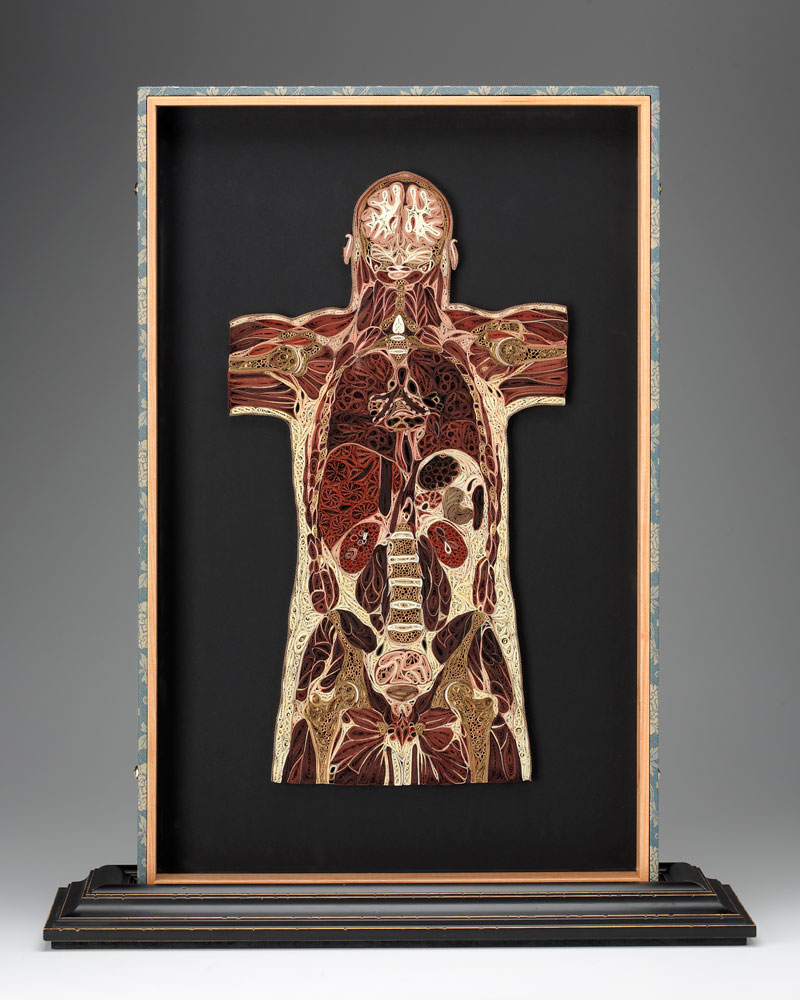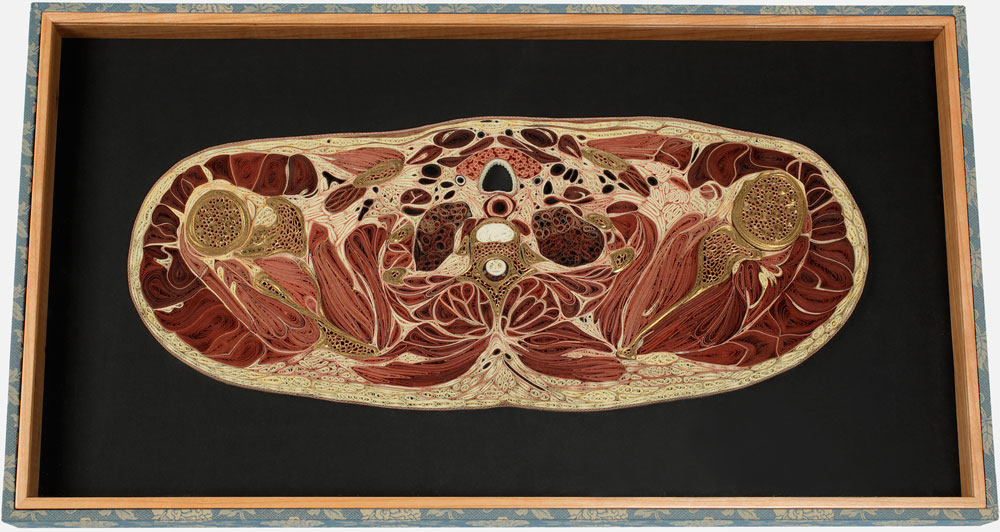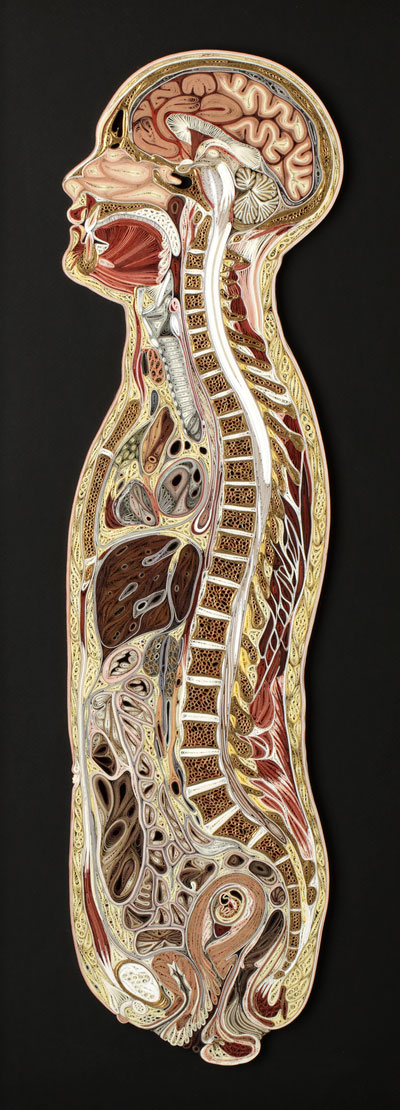
Coronal Man, 25 x 20.5 x 6.75in, Mulberry Paper, 2013
For the past five years or so my art-making practice has been focused on a centuries-old paper craft called quilling. I roll up narrow strips of paper into coils, pinch and squeeze them into the shapes I want and build those little units into a finished whole. It’s a slow process.
I enjoy showing my work, and I pay attention to what people say when they see it, especially to the things I hear often
.
I hear this a lot: “You have a lot of patience.” This gives me pause.
What, exactly, is meant by that? I think, Jeezus, I hope they don’t think I’m suffering.
I thought perhaps suffering was just what I had come to associate with the word patience, but I looked it up and the root of the word, indeed, means suffering (same as for patient in the medical sense).

Abdomen, 15 x 12.5 x 1.5in, Paper, 2011
Abdomen (detail)
My work requires a certain kind of attention, as well as a good deal of focus, faith, tenacity, and boatloads of time – but not what I’d call patience. Patience to me implies tedium. There’s an embarrassment of things in life that I experience as tedious, but making my work ain’t on the list.
To my viewers I offer this analogy: It’s like building a puzzle. Once you get rolling you don’t want to quit. The challenge is not in sticking with it, but in walking away when you ought to, your eyes and back are sore, and you know you really should get up to pee or eat or stretch or get back to the rest of your life. But watching this barnyard scene come together is now the most important thing ever. Finishing it will complete you.
I bought an old puzzle at my local junk store for a buck. It was made in the 60s and came with the following adorable instructions: 14 Tips on Jigsaw Puzzling.
Here are the tips I found, which are directly and surprisingly relevant to my process, with some added commentary…
Work on large masses of color or obvious forms.
I start in the middle and work out, building my pieces one little individual unit at a time. It’s important to establish overall movements of color and how the parts will relate to the whole in terms of color and shape and texture, and to keep this in mind as the piece slowly builds. I’m so enamored of the parts, it has always taken discipline for me to acknowledge the whole.
There’s an embarrassment of things in life that I experience as tedious, but making my work ain’t on the list.
Consult the picture on the box cover.
As far as puzzles go, I’ve always thought of this as a bit of a cheat, though in my work I think of the “box cover” as reference material, and I’m reminded of the rich benefits of looking at actual things in the world for guidance and inspiration.
Shoulders
22.75 x 12.5 x 1.5in
Mulberry Paper
2013

Carefully analyze general color and cutting pattern of the pieces.
I’ve often been told I’m “too analytical” or, less critically, “very analytical.” I’m the opposite of the intuitive artist. I’ve always navigated my way through my art by problem solving, figuring things out, deconstructing and reconstructing, being aware of the rules, and what makes sense.
When stymied, work on a different section for a while.
Whoa yeah. I don’t always recognize when tenacity is getting in my way. Sometimes you’ve got to let something go for a while. Resolve and solve some other easier problems, carry on and then maybe seeing how to approach the tricky bit will become clear.

Midsagittal Female
31 x 8 x 18.5in
Mulberry Paper
2013
Take time and emphasize enjoyment. Racing through a puzzle doesn’t give the most pleasure.
They get me!
Set up a special puzzle table.
Yes, a puzzle table of one’s own.
Frustrating, unusual pieces provide greater satisfaction when they are finally in their place.
Boy howdy!
We will continually design unusual pieces to challenge you.
I’m sure you will.
Persevere! Don’t give up!
Never.
And at no point does the list mention patience. The understanding is that this will be a slow and precise process that is meant to be pleasurable, to be savored and enjoyed. Slowness is a luxury.
I’ve had the experience of making paintings as a greeting card illustrator, on a deadline, and in which I had some, but not much personal investment in the outcome or the process, and let me tell you, that takes patience. In fact, the word “painstaking” was even written in my contract. I was required to make the work in a “painstaking” fashion.
Which leads me to wonder if people place value on work that is made slowly and by hand, because someone has suffered to make it. That’s a bit disturbing. I’d rather think that what is held in high esteem is work that was done with pleasure. If not pleasure then attention anyway, but not pain.
If more of our tasks were labors of love, if more of our possessions were made with pleasure…
I’m so grateful that in this artist’s life I have found a way to keep myself engaged, amused and out of trouble six to eight hours a day. People enjoy what I make. I get paid and praised, and introduced to interesting people who do interesting things.
I would wish this on anyone.

Praying Hands (detail), 8 x 11in, Paper, 2012
Coronal Man (detail), 25 x 20.5 x 6.75in, Mulberry Paper, 2013
Transverse Head-Tongue (detail), 14 x 11.5 x 1.5in, Paper, 2013